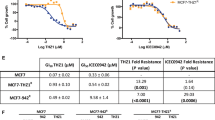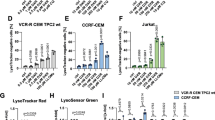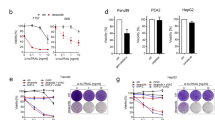Abstract
Resistance to cytotoxic agents is a major limitation for their clinical use to treat human cancers. Tumors become resistant to chemotherapy when a subset of cells undergoes molecular changes leading to overexpression of drug transport proteins, alterations in drug–target interactions or reduced ability to commit apoptosis. However, such changes may not be sufficient to explain why both resistant and nonresistant cells survive drug's action in tumors that ultimately become drug resistant. We hypothesized that, in such tumors, a cytoprotective relationship may exist between drug-resistant and neighboring drug-sensitive cells. The present study addresses the possibility that drug-resistant cells secrete in their culture medium factors able to protect sensitive cells from drug toxicity. A survival molecule, midkine, was identified by cDNA array to be expressed only in drug-resistant cells. Midkine-enriched fractions obtained by affinity chromatography exert a significant cytoprotective effect against doxorubicin in the wild-type drug-sensitive cells. Moreover, transfection of these cells with the midkine gene caused a decreased response to doxorubicin. The underlying mechanism of this cytoprotection appeared to imply activation of the Akt pathway and inhibition of drug-induced proliferation arrest as well as apoptotic cell death. These findings provide evidence for the existence of intercellular cytoprotective signals such as the one mediated by midkine, originating from cells with acquired drug resistance to protect neighboring drug-sensitive cells and thus contribute to development of resistance to chemotherapy.
This is a preview of subscription content, access via your institution
Access options
Subscribe to this journal
Receive 50 print issues and online access
$259.00 per year
only $5.18 per issue
Buy this article
- Purchase on Springer Link
- Instant access to full article PDF
Prices may be subject to local taxes which are calculated during checkout








Similar content being viewed by others
References
Chang BD, Swift ME, Shen M, Fang J, Broude EV and Roninson IB . (2002). Proc. Natl. Acad. Sci. USA, 99, 389–394.
Dalton WS and Jove R . (1999). Semin. Oncol., 26, 23–27.
Debatin KM and Krammer PH . (2004). Oncogene, 23, 2950–2966.
Emran MA, Rebbaa A and Mirkin BL . (2002). Cancer Lett., 182, 53–59.
Fulda S and Debatin KM . (2003). Cancer Lett., 197, 131–135.
Gorre ME, Mohammed M, Ellwood K, Hsu N, Paquette R, Rao PN and Sawyers CL . (2001). Science, 293, 876–880.
Gottesman MM, Hrycyna CA, Schoenlein PV, Germann UA and Pastan I . (1995). Annu. Rev. Genet., 29, 607–649.
Hartmann A, Troadec JD, Hunot S, Kikly K, Faucheux BA, Mouatt-Prigent A, Ruberg M, Agid Y and Hirsch EC . (2001). J. Neurosci., 21, 2247–2255.
Hirano T, Ishihara K and Hibi M . (2000). Oncogene, 19, 2548–2556.
Ikematsu S, Nakagawara A, Nakamura Y, Sakuma S, Wakai K, Muramatsu T and Kadomatsu K . (2003). Br. J. Cancer, 88, 1522–1526.
Johnson DE . (1998). Front Biosci., 3, d313–d324.
Kang HC, Kim IJ, Park JH, Shin Y, Ku JL, Jung MS, Yoo BC, Kim HK and Park JG . (2004). Clin. Cancer Res., 10, 272–284.
Klein B, Tarte K, Jourdan M, Mathouk K, Moreaux J, Jourdan E, Legouffe E, De Vos J and Rossi JF . (2003). Int. J. Hematol., 78, 106–113.
Li Q, Ahmed S and Loeb JA . (2004). Cancer Res., 64, 7078–7085.
Luschen S, Ussat S, Scherer G, Kabelitz D and Adam-Klages S . (2000). J. Biol. Chem., 275, 24670–24678.
Martinsson P, Liminga G, Nygren P and Larsson R . (2001). Anticancer Drugs, 12, 699–705.
Masuda K, Watanabe I, Unoki K, Ohba N and Muramatsu T . (1995). Invest. Ophthalmol. Vis. Sci., 36, 2142–2146.
Muramatsu H and Muramatsu T . (1991). Biochem. Biophys. Res. Commun., 177, 652–658.
Muramatsu T . (1993). Int. J. Dev. Biol., 37, 183–188.
Muramatsu T . (2002). J. Biochem. (Tokyo), 132, 359–371.
Owada K, Sanjo N, Kobayashi T, Mizusawa H, Muramatsu H, Muramatsu T and Michikawa M . (1999). J. Neurochem., 73, 2084–2092.
Pommier Y, Sordet O, Antony S, Hayward RL and Kohn KW . (2004). Oncogene, 23, 2934–2949.
Qi M, Ikematsu S, Ichihara-Tanaka K, Sakuma S, Muramatsu T and Kadomatsu K . (2000). J. Biochem. (Tokyo), 127, 269–277.
Ratovitski EA, Kotzbauer PT, Milbrandt J, Lowenstein CJ and Burrow CR . (1998). J. Biol. Chem., 273, 3654–3660.
Rebbaa A, Chou PM and Mirkin BL . (2001). Mol. Med., 7, 393–400.
Rebbaa A, Zheng X, Chou PM and Mirkin BL . (2003). Oncogene, 22, 2805–2811.
Roumiantsev S, Shah NP, Gorre ME, Nicoll J, Brasher BB, Sawyers CL and Van Etten RA . (2002). Proc. Natl. Acad. Sci. USA, 99, 10700–10705.
Sakaguchi N, Muramatsu H, Ichihara-Tanaka K, Maeda N, Noda M, Yamamoto T, Michikawa M, Ikematsu S, Sakuma S and Muramatsu T . (2003). Neurosci. Res., 45, 219–224.
Satoh J, Muramatsu H, Moretto G, Muramatsu T, Chang HJ, Kim ST, Cho JM and Kim SU . (1993). Brain. Res. Dev. Brain Res., 75, 201–205.
Schmitt E, Sane AT, Steyaert A, Cimoli G and Bertrand R . (1997). Biochem. Cell Biol., 75, 301–314.
Shannon KM . (2002). Cancer Cell, 2, 99–102.
Shay JW and Roninson IB . (2004). Oncogene, 23, 2919–2933.
Stoica GE, Kuo A, Powers C, Bowden ET, Sale EB, Riegel AT and Wellstein A . (2002). J. Biol. Chem., 277, 35990–35998.
Unoki K, Ohba N, Arimura H, Muramatsu H and Muramatsu T . (1994). Invest. Ophthalmol. Vis. Sci., 35, 4063–4068.
West KA, Castillo SS and Dennis PA . (2002). Drug Resist. Update, 5, 234–248.
Yaginuma H, Shiraiwa N, Shimada T, Nishiyama K, Hong J, Wang S, Momoi T, Uchiyama Y and Oppenheim RW . (2001). Mol. Cell Neurosci., 18, 168–182.
Acknowledgements
This investigation was supported in part by grants from the National Cancer Institute – NIH (No. 1R01 CA096616-01A1), John W Anderson Foundation, North Suburban Medical Research Junior Board, Medical Research Junior Board Foundation, Medical Research Institute Council, R Wile Foundation, and the Children's Memorial Research Center Program in Cancer Biology and Chemotherapy. We express our appreciation to Dr Eric G Bremer for allowing the use of the Quantitative RT–PCR machine, and Ms Roberta Gerard and Mr William Goossens for their excellent assistance in preparation of the manuscript and all illustrations, respectively.
Author information
Authors and Affiliations
Corresponding author
Additional information
Supplementary information accompanies the paper on the Oncogene website (http://www.nature.com/onc)
Supplementary information
Rights and permissions
About this article
Cite this article
Mirkin, B., Clark, S., Zheng, X. et al. Identification of midkine as a mediator for intercellular transfer of drug resistance. Oncogene 24, 4965–4974 (2005). https://doi.org/10.1038/sj.onc.1208671
Received:
Revised:
Accepted:
Published:
Issue Date:
DOI: https://doi.org/10.1038/sj.onc.1208671
Keywords
This article is cited by
-
CAF-derived midkine promotes EMT and cisplatin resistance by upregulating lncRNA ST7-AS1 in gastric cancer
Molecular and Cellular Biochemistry (2022)
-
Midkine (MDK) growth factor: a key player in cancer progression and a promising therapeutic target
Oncogene (2020)
-
Midkine derived from cancer-associated fibroblasts promotes cisplatin-resistance via up-regulation of the expression of lncRNA ANRIL in tumour cells
Scientific Reports (2017)
-
CD133 and DNA-PK regulate MDR1 via the PI3K- or Akt-NF-κB pathway in multidrug-resistant glioblastoma cells in vitro
Oncogene (2016)
-
Diagnostic and predictive role of cell-free midkine in malignant pleural effusions
Journal of Cancer Research and Clinical Oncology (2013)



